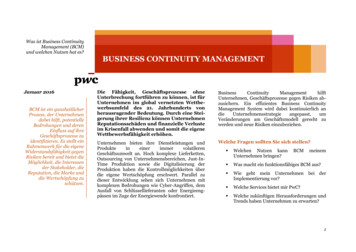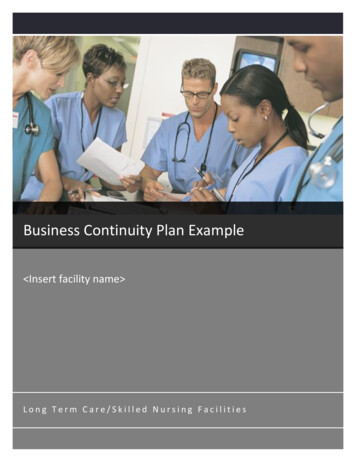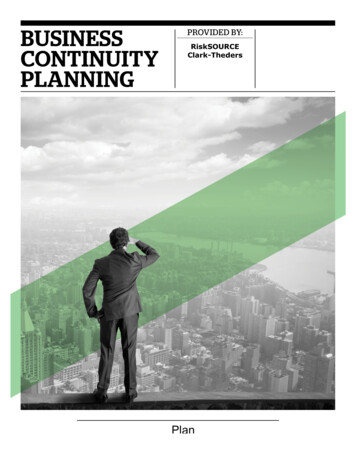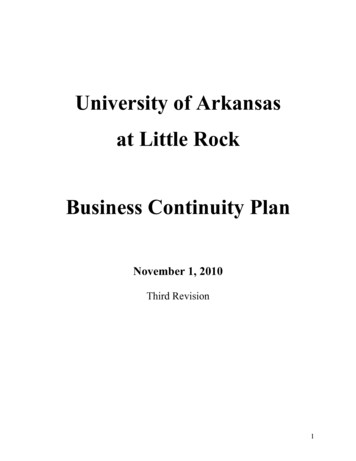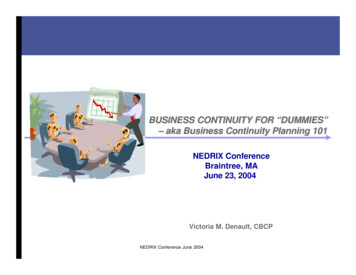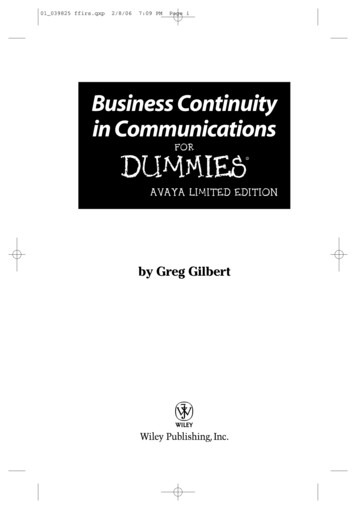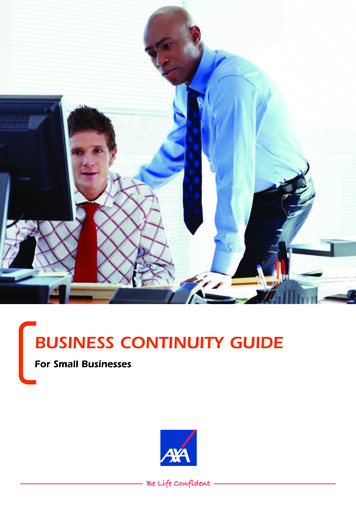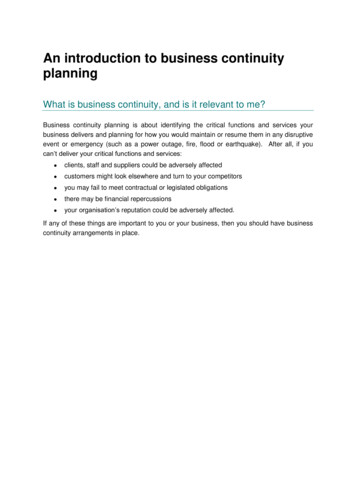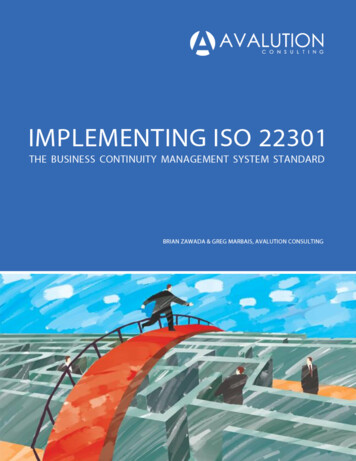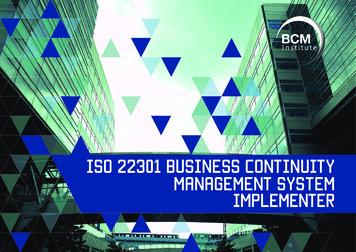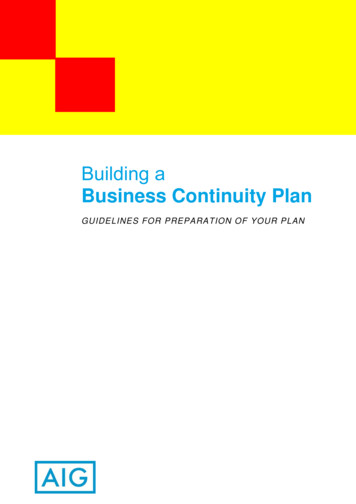
Transcription
AIG Europe (UK) LimitedThe AIG Building, 58 Fenchurch Street, London EC3M 4AB.Tel: 44 (0) 20 7954 7000Fax: 44 (0) 20 7954 7001This insurance is provided by AIG Europe (UK) Limited and underwritten by New Hampshire Insurance Company and/or Landmark Insurance CompanyLimited. AIG Europe (UK) Limited is an appointed representative of New Hampshire Insurance Company and Landmark Insurance Company Limited. NewHampshire Insurance Company and Landmark Insurance Company Limited are authorised and regulated by the Financial Services Authority. AIG Europe(UK) Limited, New Hampshire Insurance Company and Landmark Insurance Company Limited are member companies of American International Group,Inc. (AIG).Building aBusiness Continuity PlanGUIDELINES FOR PREPARATION OF YOUR PLAN
Building a Business Continuity PlanA disaster is defined as “any unplanned event that results in the inability of the business to support operations inwhole or in part”. A business is vulnerable to three different types of disaster: Natural disasters Wilful damage Accidental damageTo minimise the damage to the business by such an occurrence, it is necessary to have a recovery plan, whichaddresses the worst case scenario – destruction of the building or main facility. See Appendix A for listing ofpotential disasters.BUSINESS CONTINUITY PLANNING GUIDELINESNo matter what the size of the business, similar principles will apply: A senior person in the business should take ownership of the business continuity plan. The plan should beallocated the same importance in business planning as, for example quality management, cash flow orhealth and safety The responsibility of managing the business continuity plan must be clearly established within thebusiness and everyone should know the importance of the plan and who has overall responsibility A small team of suitably qualified and/or experienced people should be assembled to review the businessoperations and itemise the key features and areas of operation The scope of the work must be established. An organisation may already have, for example, adequaterecovery plan for its IT system. Such a plan would however need to be included in the completedBusiness Continuity PlanIt is imperative that a business is able to respond to any type of emergency. A disaster or emergencysituation is, by definition, unexpected. The business continuity plan should be prepared along thefollowing principles: The plan should have a broad scope if it is to effectively address the many disaster scenarios thatcould affect the company. It should not distinguish between a partial loss of service and a complete loss of services andfacilities. A “worst case scenario” should be the basis for developing the plan - destruction of themain or primary facility. Because the business continuity plan will be written based on the above assumptions, less criticalsituations can be handled by using only the needed portions of the plan, with minor (if any)alterations required.This document identifies broad issues that should be addressed in your planning. It is recommended that you readthrough all the items first, before starting. A checklist has been provided for each of the three phases highlightedabove. The purpose of the checklist is to assist the team when preparing a business continuity plan. It should befilled in as the planner progresses through the process of developing, documenting, and implementing thebusiness continuity plan. Version 005, May 2013Building a Business Continuity Plan-2-
Components of a Business Continuity PlanA business continuity plan is a working document that reflects the business as it is and not as it was. It should beconcise and easy to use. The procedures state what tasks should be done, but not necessarily how to carry themout. The reason such specifics are avoided is that a successful business continuity plan requires the flexibility tobe creative, within a given situation, and not be encumbered by strict compliance and detailed procedures. Abusiness continuity plan should identify decisions (including options) to be made during a disaster.There are three stages to creating a business continuity plan:i.ii.iii.Conduct a risk assessment and an analysis of the impact on the business in order to determine themagnitude of the exposure to threatsDevelop and document the business continuity planTest, approve, and implement the business continuity plan. This stage includes maintaining the businesscontinuity plan on an ongoing basis to meet the changing demands of the business.StagesObjectiveI. Risk Assessment1. Risk Evaluation 2. Business Impact Analysis Identify critical business functions essential for continued serviceor production.Determine the events that can adversely affect your company,the damage that such events can cause and the controls neededto prevent or minimise the effects of a loss potential.Identify the impacts that result from disruption that can affect thecompany and the techniques that can be used to quantify andqualify such impacts.Prioritise critical business functions.II. Develop and Document Business Continuity Plan.1. Develop Recovery Strategy Determine and guide the selection of alternative recoveryoperating strategies to be used to maintain the critical functions.2. Document Plan Organise and document a written plan. Senior managementshould review and approve the proposed plan.III. Test, Approve and Implement Business Continuity Plan.1. Test Plan Develop testing criteria and procedures. Coordinate, test, andevaluate the plan. Document all results.2. Approve and Implement Plan Obtain senior management endorsement of plan.3. Maintain Plan Develop processes to keep the plan up-to-date with reviews andtests completed at a maximum of 12-month intervals.Ensure the plan is in-line with the strategic direction of thecompany. Version 005, May 2013Building a Business Continuity Plan-3-
I.RISK ASSESSMENT1. Risk Evaluation - Identify Critical Business FunctionsThis part of the process is aimed at identifying those processes and functions that are critical to the operation ofthe business; the speed that the impact of their loss will be felt and within what time-scale.Critical business operations are generally those which do not have scheduling flexibility. Initially entire departmentsor operational areas may not be needed. These departments may however become critical depending on theduration of the emergency. Therefore, the time frame of when a function becomes critical should also beconsidered. It may be useful to allocate to each operation a time frame within which the impact would begin to befelt: for example this may be within 4 hours, within 24 hours, within 1 week. When planning, it will help to list thecritical functions and the managers/people in charge of them. (See Appendix E for sample of blank template.)The following items should be reflected in the critical business section of the business continuity plan. Identify the position(s) and employee(s) responsible for each function List the employees' home, mobile and work phone numbers and address in case mail is necessary List the resources needed for each critical function. Consider the minimum necessary for continuedoperations Identify any variances in the time of year for critical functions (i.e. temporary help employed everyNovember and December to assist warehouse staff etc.) Identify any variances in resource needs List alternate sites for a complete loss of services, include: space needed and contact for alternate site(home, mobile and work phone number) Document your means for relocating personnel safely Identify how you will relocate equipment Document who is responsible for relocation logistics; include their home, mobile and work phone numbers Document alternative (back-up) methods for relocating people and equipment. Plan to use the minimumnumber of people and equipment for restoring critical business functions. Include an alternate person forlogistical responsibility2. Business Impact Analysis - Identify Risk and Impact on Business Functions All business operations must perform a risk and business impact analysis. Based on the level of riskassociated with the functions performed, a recovery plan may be required. The risk analysis should beupdated at least annually and after any major system or operational change which has resulted in amaterial effect on the risk associated with a given operation. One method for determining the risk associated with an activity is to document all the functions performedby each department. Once the primary functions have been identified, the operations and processesshould be ranked in order of priority: essential, important and non-essential. Recovery Priority - For every product or service provided by the business unit / function, list and describethe impact to the business assuming all resources (personnel, equipment, etc.) become unavailable.Critical business functions should be prioritised according to their impact on day-to-day operations.For exampleClassificationDescriptionRecovery Time FramePriority A(Essential)Functions absolutely essential to remain operationalUp to 48 hours after disasterdeclarationPriority B(Important)Functions that are critical and should be performedin a timely manner following the completion ofpriority “A” functions3 – 7 days after disaster declarationPriority C(Non-essential)Functions that enhance operations but are less timecritical for the company to remain operational.8- 30 days after disaster declarationVersion 005, May 2013Building a Business Continuity Plan-4-
The importance of some functions will vary depending upon when the disaster occurs. For example,accounting and tax-related functions are generally tied to statutory or regulatory deadlines, etc.Quantitative impact Assess the quantitative impact of the loss to the business. If an area provides a support function and lossof the process or service would primarily impact other business functions, the quantitative loss impact willbe based on the dependent business operations. State the duration of the impact. It is up to the business unit to determine the definition of short, moderate,and long-term as they pertain to the business product / service. For example, short term may be one day,moderate term one week, and long-term one month. Describe the impacts of the loss of the business product / function and estimate the qualitative impact.Quantify using the following ranges of values, the loss for each of the impact time value.Example:1.Less than 10,000per duration2. 10,000 – 100,000per duration3. 100,000 – 500,000per duration4. 500,000 – 1,000,000per duration5. 1,000,000 – 2,500,000per duration6. 2,500,000 – 5,000,000per duration7. 5,000,000 – 10,000,000per duration8. 10,000,000 – 50,000,000per duration9. 50,000,000 – 100,000,000per durationOver 100,000,000per duration10.(See Appendix F for sample of blank template.)Version 005, May 2013Building a Business Continuity Plan-5-
II.DEVELOP and DOCUMENT BUSINESS CONTINUITY PLANThe previous work will have identified the organisation of the business; the risks facing it and the potential damageto the business. Management must decide on which level of risk is acceptable to the business as this will helpdetermine the actions to be taken and how the Business Continuity Plan will be developed.The options are:1. Accept the current situation.2. Reduce the likelihood and /or the impact of the disaster to a more acceptable level.3. Eliminate or reduce the potential effects to a negligible level.The first option relies on the ability to recover from the event quickly. The analysis and assessment exercise willhave identified the dangers likely to be encountered, however by the time recovery has been completed customersmay have found alternative suppliers.The third option can involve considerable expense.The second option is often the preferred one as the exposure of the business is reduced as far as reasonablypracticable and the consequent effects lessened. The Business Continuity Plan then details the manner in whichthe remaining risk will be managed.1.Develop Recovery StrategyIdentify Communication Channels Specify what other locations, departments and personnel will need to be contactable during anemergency. Identify what you might need to discuss or communicate Indicate personnel that will need to be accessible Determine how you will communicate. What might be done if there are no telephones immediatelyavailable to you or the other party? Set your alternatives in order of priority and document it. You maywant to consider two-way radio for the most important members of your emergency management team Indicate how your employees will be notified of an emergency during non-working hours. If you plan onusing radio stations, it is recommended that you arrange for two stations. Prior arrangements with radiostations are usually necessary Determine when you will need to communicate with people managing the critical operations - at the start? continually?.intermittently? Indicate any differences in time you will need to communicate with your staff or with foreign countries asthis will affect your communication plans (i.e. USA, Europe, etc.) Consider media press statement and appoint a designated spokespersonIdentify Necessary Resources Document the minimum number of personnel needed for critical functions Decide who is needed to perform the critical functions. Aside from the managers you named earlier, whoelse might be need and how many (or how few) people will be needed? Consider what will be need to perform the critical functions in terms of alternate manufacturing,warehousing and office space, computer hardware, operating systems, files, telephones, etc. Think interms of minimal amounts Decide how you will obtain the requisite material and from where (supplier, warehouse, factory, off-sitestorage)? Do not rely on only one supplier. Establish alternate sources of supplies wherever possible Indicate when these items will be needed. Will they be needed at all stages of a relocation, at thebeginning, or at the end? The most practical alternative for maintaining production or services in case of a disaster should beresearched and evaluated. It is important to consider all aspects of the companyVersion 005, May 2013Building a Business Continuity Plan-6-
Recovery alternatives may include: Manufacturing assistance;a) within the companyb) third party manufacturers Alternate warehousing and distribution facilities Hot sites for computer services Reciprocal agreements Multiple computers Service centres Consortium arrangement Suppliers ofa) equipmentb) raw materialsc) services Combinations of the above Detail equipment needed at each of the alternate sites Specify what equipment is available at each alternate site Identify the means for getting additional equipment that will be required Indicate time frames for equipment needs Identify all contacts for equipment needs (i.e. manufacturers, wholesalers, agents.). List their home,mobile and work telephone numbers For a listing of data gathering materials and documentation that should be maintained see Appendix DDisaster Decision Making Determine which teams will be needed before, during, and after a disaster takes place. A good startingpoint is to envision the chain of events after a disaster occurs or during an emergencySee Appendix B for a listing of teams that may be created Identify the members of the decision-making teams. Include home, mobile and work numbers for eachteam member and home addresses in case mail is necessary The role and responsibilities of each team should be addressed at a high level. The specific tasks thateach group will be responsible for completing, such as building evacuation, power back-up issues,notification of authorities, notification of employees, should be defined At what point in time should this chain of command or team take effect? Propose locations where a team could be based Every team member should have at least two copies of the applicable parts - one in his / her desk andone at home. The idea is to be able to act quickly while reducing confusion. This kind of workingdocument is to be updated as needed, and at the least, annuallyDisaster Assessment Define what constitutes a major disaster for your operations (e.g. a loss of services for more than 3 or 5days). What, in your opinion, constitutes a disaster for the business? Describe what you consider as thedifference between a minor set back and a disaster How would the extent of an emergency be assessed? Describe / list your sources and locations of information and where you will get information, for disasterassessment and for returning to normal operations Identify who is needed to make assessments about the disaster?Version 005, May 2013Building a Business Continuity Plan-7-
Create Accelerated Access PlanAny condition that delays the return to normality, such as prolonged inability to re-enter the disaster area, carrymany cost with them. Tangible costs include loss of income, wages, and assets. A well conceived and executed“access plan” will ensure that the right people can quickly enter the right areas at the right time.2.Document The Plan Poorly written plans are difficult to use, quickly outdated, and can be extremely frustrating. Well-writtenplans reduce the time required to read and understand the procedures and therefore, result in a betterchance of success if the plan has to be used. Well-written plans are brief and to the point A certain writing format should be employed when writing the plan. A standard format for the proceduresshould be developed to facilitate consistency and conformity throughout the plan. Standardisation isespecially important if several people write the procedures If any aspect of the plan is based on certain assumptions, write them down. Throughout the attachedchecklist, the planner is reminded to document all assumptions. See Appendix C for a list of commonplanning assumptions If the planner encounters difficulty in preparing the plan, it may pertain to the fact that he / she is trying toplan for areas that he/ she should not be planning for. You cannot do someone else's plans. This exerciseshould be departmental-driven. The departmental managers need to determine what their criticalfunctions are, and who the people are that are needed to perform those functionsIII.TEST AND IMPLEMENT BUSINESS CONTINUITY PLAN1.Test Plan Develop testing criteria and procedures. Procedures to test the business continuity plan should bedocumented Perform testing. It is essential that the plan be thoroughly tested and evaluated on a regular basis (at leastannually) The plan should be updated to correct any problems identified during the test Types of tests include: Checklist tests Simulation tests Parallel tests Full recovery / interruption tests The tests will provide the company with the assurance that all necessary steps are included in the plan.Other reasons for testing include: Determining the feasibility and compatibility of backup facilities and procedures Identifying areas in the plan that need modification Providing training to the team managers and team members Demonstrating the ability of the company to recover Providing motivation for maintaining and updating the business continuity plan If certain functions within the company are out-sourced / processed by a third-party (i.e. spray painting,electro-plating, distribution) management should: Evaluate the adequacy of the third party’s business continuity plan. Ensure that the company’s business continuity plan is compatible with the respective thirdparty’s plan.2.Approve and Implement Plan Once the business continuity plan has been written and tested, the plan should be approved by topmanagement. It is top management’s ultimate responsibility that the company has a documented andtested planVersion 005, May 2013Building a Busine
AIG Europe (UK) Limited . The AIG Building, 58 Fenchurch Street, London EC3M 4AB. Tel: 44 (0) 20 7954 7000 Fax: 44 (0) 20 7954 7001 . This insurance is provided by AIG Europe (UK) Limited and underwritten by New Hampshire Insurance C
